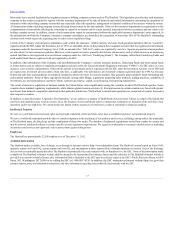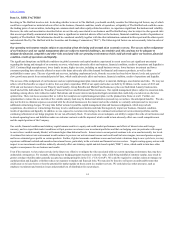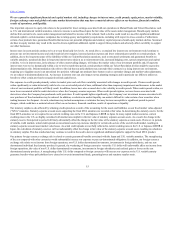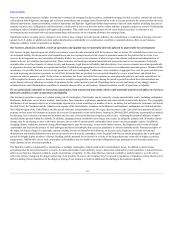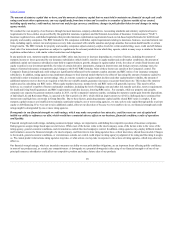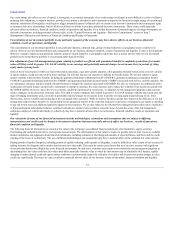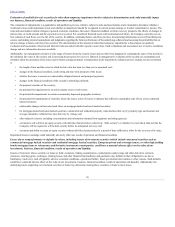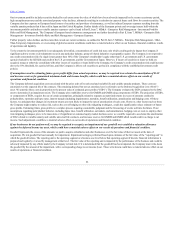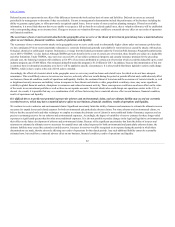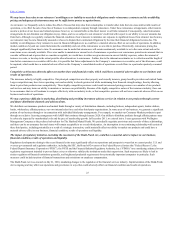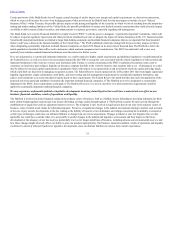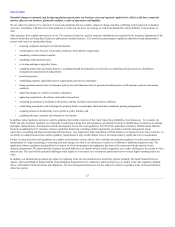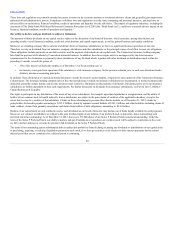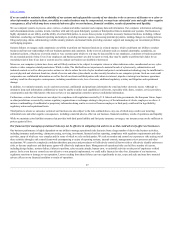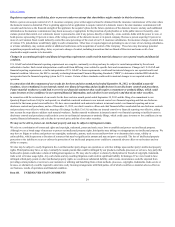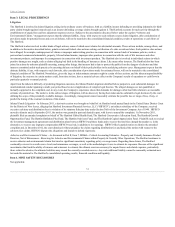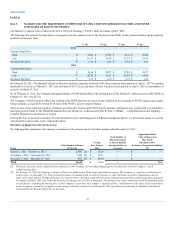The Hartford 2012 Annual Report Download - page 23
Download and view the complete annual report
Please find page 23 of the 2012 The Hartford annual report below. You can navigate through the pages in the report by either clicking on the pages listed below, or by using the keyword search tool below to find specific information within the annual report.
Table of Contents
We may incur losses due to our reinsurers' unwillingness or inability to meet their obligations under reinsurance contracts and the availability,
pricing and adequacy of reinsurance may not be sufficient to protect us against losses.
As an insurer, we frequently seek to reduce the effect of losses that may arise from catastrophes to transfer other risks that can cause unfavorable results of
operations, or to effect the sale of one line of business to an independent company through reinsurance. Under these reinsurance arrangements, other insurers
assume a portion of our losses and related expenses; however, we remain liable as the direct insurer on all risks reinsured. Consequently, ceded reinsurance
arrangements do not eliminate our obligation to pay claims, and we are subject to our reinsurers' credit risk with respect to our ability to recover amounts due
from them. Although we regularly evaluate the financial condition of our reinsurers to minimize our exposure to significant losses from reinsurer insolvencies,
our reinsurers may become financially unsound or choose to dispute their contractual obligations by the time their financial obligations become due. The
inability or unwillingness of any reinsurer to meet its financial obligations to us could have a material adverse effect on our results of operations. In addition,
market conditions beyond our control determine the availability and cost of the reinsurance we are able to purchase. Historically, reinsurance pricing has
changed significantly from time to time. No assurances can be made that reinsurance will remain continuously available to us to the same extent and on the
same terms as are currently available. If we were unable to maintain our current level of reinsurance or purchase new reinsurance protection in amounts that we
consider sufficient and at prices that we consider acceptable, we would have to either accept an increase in our net liability exposure, reduce the amount of
business we write, or develop to the extent possible other alternatives to reinsurance. Further, due to the inherent uncertainties as to collection and the length of
time before reinsurance recoverables will be due, it is possible that future adjustments to the Company’s reinsurance recoverables, net of the allowance, could
be required, which could have a material adverse effect on the Company’s consolidated results of operations or cash flows in a particular quarterly or annual
period.
Competitive activity may adversely affect our market share and financial results, which could have a material adverse effect on our business and
results of operations.
The insurance industry is highly competitive. Our principal competitors are other property and casualty insurers, group benefits providers and mutual funds.
Larger competitors may have lower operating costs and an ability to absorb greater risk while maintaining their financial strength ratings, thereby allowing
them to price their products more competitively. These highly competitive pressures could result in increased pricing pressures on a number of our products
and services and may harm our ability to maintain or increase our profitability. Because of the highly competitive nature of the insurance industry, there can
be no assurance that we will continue to compete effectively with our industry rivals, or that competitive pressure will not have a material adverse effect on our
business and results of operations.
We may experience difficulty in marketing, distributing and providing investment advisory services in relation to our products through current
and future distribution channels and advisory firms.
We distribute our insurance products and mutual funds through a variety of distribution channels, including brokers, independent agents, broker-dealers,
banks, wholesalers, affinity partners, our own internal sales force and other third-party organizations. In some areas of our business, we generate a significant
portion of our business through or in connection with individual third-party arrangements. For example, we market our Consumer Markets products in part
through an exclusive licensing arrangement with AARP that continues through January 2020. Our ability to distribute products through affinity partners may
be adversely impacted by membership levels and the pace of membership growth. In December 2011, we entered into a 5-year agreement with Wellington
Management Company as the preferred sub-advisor for The Hartford Mutual Funds. We periodically negotiate provisions and renewals of these relationships,
and there can be no assurance that such terms will remain acceptable to us or such third parties. An interruption in our continuing relationship with certain of
these third parties, including potentially as a result of a strategic transaction, could materially affect our ability to market our products and could have a
material adverse effect on our business, financial condition, results of operations and liquidity.
The impact of regulatory initiatives, including the enactment of the Dodd-Frank Act, could have a material adverse impact on our business,
financial condition, results of operations and liquidity.
Regulatory developments relating to the recent financial crisis may significantly affect our operations and prospects in ways that we cannot predict. U.S. and
overseas governmental and regulatory authorities, including the SEC, the Board of Governors of the Federal Reserve System (the "Federal Reserve"), the
Federal Deposit Insurance Corporation (“FDIC”), the NYSE and the Financial Industry Regulatory Authority, Inc. (“FINRA”) are considering enhanced or new
regulatory requirements intended to prevent future crises or otherwise stabilize the institutions under their supervision. Such measures are likely to lead to
stricter regulation of financial institutions generally, and heightened prudential requirements for systemically important companies in particular. Such
measures could include taxation of financial transactions and restrictions on employee compensation.
The Dodd-Frank Act was enacted on July 21, 2010, mandating changes to the regulation of the financial services industry. Implementation of the Dodd-Frank
Act is ongoing and may affect our operations and governance in ways that could adversely affect our financial condition and results of operations.
23


